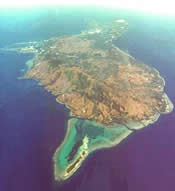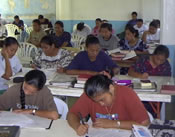
In the spring of 2005 I (Brad) was doing some work on the Internet and happened across a link to a school I had never heard of. I clicked on the link and discovered Pacific Islands Bible College. I was impressed with the diversity of the faculty -- Baptist, Lutheran, Presbyterian, Wesleyan, American, German, Dutch, Micronesian...
Then I realized that the school had been founded by Liebenzell missionaries to serve the
 islanders of Micronesia. These are the same people that the late Rose Notehelfer, a Liebenzell missionary, had worked with before WWII. (Rose, who was retired and living at Mission Springs when I was on summer staff there, used to come once a week to our campfires at Frontier Ranch to tell missionary stories. So I had heard about the Pacific Islands people over and over again during the summers I worked at Mission Springs.) That piqued my curiosity.
islanders of Micronesia. These are the same people that the late Rose Notehelfer, a Liebenzell missionary, had worked with before WWII. (Rose, who was retired and living at Mission Springs when I was on summer staff there, used to come once a week to our campfires at Frontier Ranch to tell missionary stories. So I had heard about the Pacific Islands people over and over again during the summers I worked at Mission Springs.) That piqued my curiosity.I sent off a brief email introducing myself to PIBC's president Dave Owen.
When Dave was in California a few months later we got together for two hours and he ended up inviting us to visit Guam for a couple of weeks so I could teach at the school. Cheryl and I took two weeks vacation in October 2005 and did just that. We stayed with Dave and his wife Joyce. It was a great experience and we really grew to love the people there.
The faculty, almost all of whom are missionaries, then asked us to consider joining them on a more permanent basis. After much prayer and consideration we decided to step forward to see if the doors for this kind of ministry would stay open for us.
When did you arrive on Guam? How long do you think you'll stay there?
We arrived on Guam in August of 2006.
 At this point we are saying that we are planning to be here for 3-5 years. But it is possible that we could extend that term. We own a home on Guam.
At this point we are saying that we are planning to be here for 3-5 years. But it is possible that we could extend that term. We own a home on Guam.What exactly are you doing?
Cheryl is the business manager for Pacific Islands Bible College. This position has to do with helping to manage the financial aid that the students on all our campuses receive. She is also working for pay for 15 hours per week at a church in the community. (Her off campus job is one way that we are helping to self-fund about 30% of our mission budget.)
I (Brad) am the vice president of academic affairs at PIBC. I also teach classes that are related to practical ministry and leadership development -- for example, preaching and spiritual formation.
Are your children with you?
Kirk is a linguist working out of San Francisco.
Kent graduate from UC Irvine in June 2009 is with us this fall (2009) as a volunteer at PIBC -- teaching English as a Second Language classes and helping with remedial academic work.
Betsy is a third year university student at UC Berkeley.
Where is Guam? What's it like?

A self-governing US territory, Guam is the largest island in the Marianas Islands -- although it is only 212 square miles. If you're looking on a globe get a magnifying glass out and look east of the Philippines. If you're using a positioning device you can find it at 13° 26' 31" N, 144° 46' 35".
Filipinos are the largest people group on Guam, making up about 40% of the population. The native Chamorros make up about 35% of the island's population. There are strong Korean, Chinese, and Japanese communities, too. When you factor in the US military presence (Air Force and Navy) you have an extremely mixed region. English is the common language.
Tourism is big business on Guam -- with most visitors coming from Japan and Korea. However, more and more Chinese are making the island a destination.
Guam, being just north of the equator, is tropical. Highs are typically a sweaty 88 degrees but it drops into the upper 70's at night. There is lots of jungle ("boonie").
No place on the island is further than 4 miles or so from the ocean. It's quite beautiful -- wonderful beaches with a corral reef surrounding the island. However, Guam is also known for typhoons and earthquakes. So most houses are concrete bunkers.
The people are extraordinarily friendly but the government has a reputation for corruption and mismanagementent. Someone described Guam as a third world country with a thin veneer of America laid over it. That might be a bit of hyperbole but the politics of Guam are a bit wilder and crazier than anywhere we've lived before.
How big is the school? Where do the students come from?

The school, which offers certificates, AA, and BA degrees, has about 200 students enrolled. Most come from the different islands such as Chuuk, Yap, Palau, and the Marshall Islands. There are also students from Asia -- e.g. China, Korea, Bangladesh and the Philippines.
English is the language of instruction, although, it is a second language for almost all of the students --which makes learning and teaching a challenge.
The BA degree is foundational for pastors, teachers, and government workers in the region.
In the fall of 2009 the school launched a graduate level seminary program with a master of arts in religion (MAR) degree.
What are some of the biggest challenges facing people in Micronesia?
Globalization is affecting the Islands and will do so even more dramatically in the near future. The Internet will soon be available on every little island out in the Pacific (Guam already has great Internet access) and people will be exposed to ideas and images which have great potential to change their lives and cultures (for better and worse).

Most Micronesians live on very isolated islands. There are about 400,000 people out here in the middle of the Pacific Ocean -- including the 170,000 on Guam. And island life is not as romantic as Americans often envision. Young people struggle with boredom, lack of opportunity, substance abuse, and suicide. A lot of their "issues" are very similar to those in rural Alaska -- including high levels of sexual abuse.
Christianity has been present on the Islands in various forms for over 100 years. Yet there are still pockets of darkness. Many people are afraid of spirits and practice a syncretistic mixture of Christianity and Animism.
What mission agency are you with?
We are "Project Missionaries" with the Evangelical Covenant Church -- working in partnership with our kindred spirits from Liebenzell. Project Missionaries typically go abroad for three to five years to accomplish a specific assignment. Ours involves the development of leaders for the evangelical churches in the Western Pacific.
What if I want to support you, how do I do that?
We need prayer partners. And we still need financial partners. If you are interested in being a part of either of these teams, or just want to receive updates, send me email.
No comments:
Post a Comment